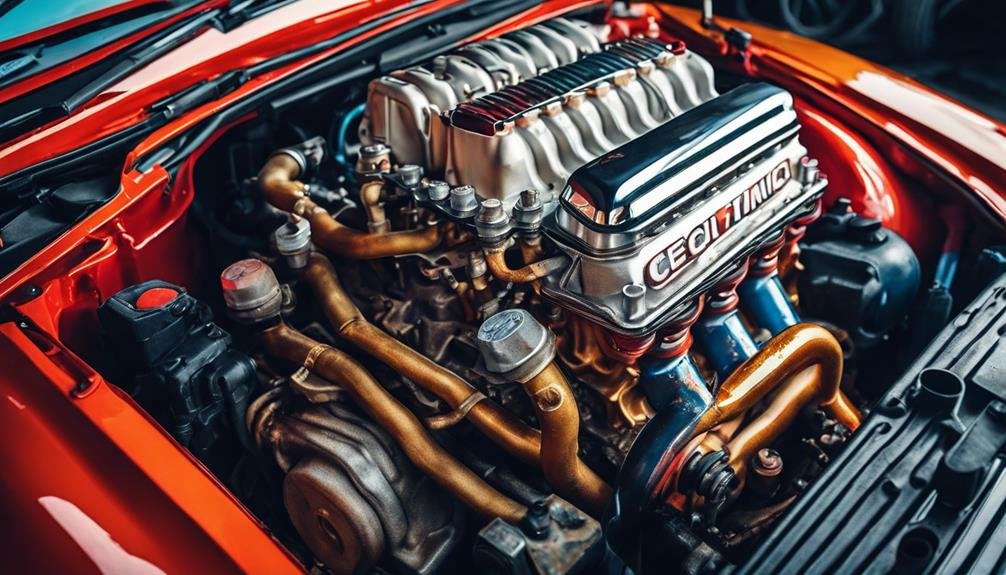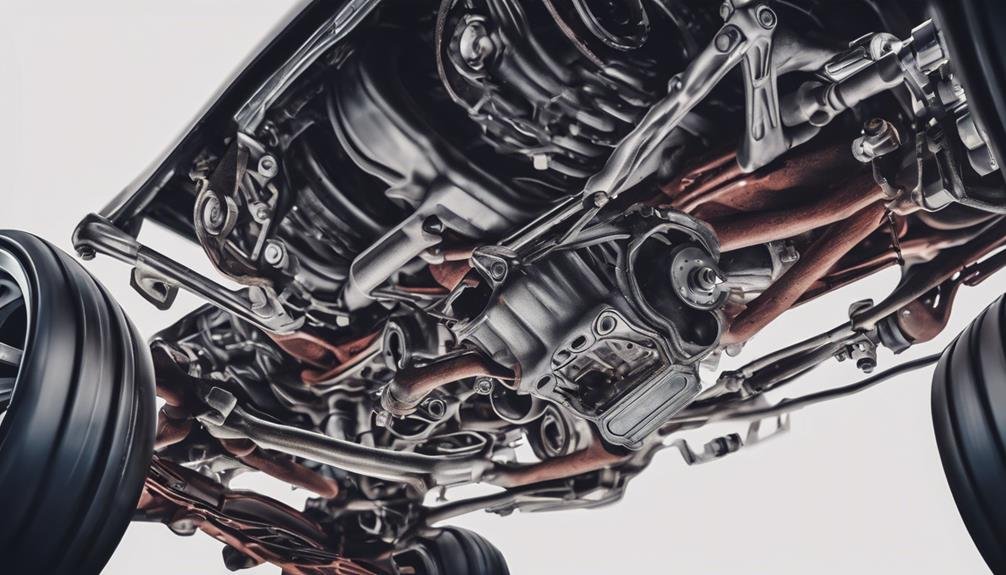As you investigate the key parts of your car, you'll uncover six primary systems working together to keep your vehicle running smoothly. The engine and transmission systems power your car, while fuel and ignition components guarantee efficient combustion. Cooling and lubrication systems regulate engine temperature and reduce friction. Electrical and starting systems power your car's electrical components, and suspension and steering components absorb shocks and control direction. Ultimately, braking and exhaust systems slow down or stop your car and minimize emissions. As you continue to examine these systems, you'll reveal the intricate details that keep your car on the move.
Key Takeaways
- A car's engine and transmission systems work together to convert chemical energy into mechanical energy for movement.
- The fuel and ignition components, including the fuel pump and spark plugs, ensure efficient combustion in the engine.
- The cooling and lubrication systems, including the radiator and oil filter, regulate engine temperature and reduce friction.
- The electrical and starting systems, including the battery and starter motor, power the car's electrical components and initiate engine operation.
- The suspension, steering, braking, and exhaust systems work together to control the car's movement, safety, and environmental impact.
Engine and Transmission Systems
As you investigate the inner workings of your vehicle, you'll find that the engine and transmission systems are the driving forces behind your car's movement.
The engine, an internal combustion engine, is the heart of your car, converting fuel into energy through a complex process. It's here that components like pistons, crankshaft, camshaft, and valves work together in harmony to generate power for your vehicle.
This power is then transferred to the transmission system, which enables your car to move forward or backward. You have two options for transmission systems: manual transmissions, which require you to shift gears, or automatic transmissions, which do it for you based on speed and power needs.
Regardless of the type, proper maintenance of both the engine and transmission systems is essential for optimal vehicle performance and longevity. By understanding how these systems work together, you'll be better equipped to take care of your car and make sure it runs smoothly for years to come.
Fuel and Ignition Components
Your car's fuel and ignition components collaborate harmoniously to guarantee the engine runs efficiently. The fuel pump, located inside the fuel tank, uses an electric motor to create pressure for fuel delivery. Spark plugs provide high-voltage sparks to ignite the air-fuel mixture in the engine cylinders, ensuring efficient combustion.
The cooling fan plays a critical role in drawing air through the radiator to help regulate the engine temperature. The ignition system generates well-timed sparks for efficient combustion of the air-fuel mixture in the cylinders.
The alternator converts AC to DC to charge the battery and powers the vehicle's electrical system while the engine is running. By working together, these components ensure your car runs smoothly and efficiently, providing the power you need to get where you're going.
Cooling and Lubrication Systems

You depend on your car's cooling and lubrication systems to keep its engine running smoothly, just as the fuel and ignition components work together to power your vehicle. These systems play a vital role in maintaining peak engine performance and preventing damage.
The cooling system, which includes the radiator, water pump, thermostat, and hoses, circulates coolant through the engine block to regulate engine temperature. Meanwhile, the lubrication system, comprising the oil pump, oil filter, and oil passages, distributes oil to engine components to reduce friction and wear.
Here are some key components of these systems:
- Coolant flowing through the radiator to dissipate heat
- The water pump pushing coolant through the engine block
- The thermostat regulating engine temperature
- Oil being filtered and pumped through the engine's moving parts
- Hoses connecting the cooling system's components together
Electrical and Starting Systems
The car's electrical and starting systems work together to power the vehicle's components and initiate engine operation. At the heart of this system is the car battery, which converts chemical energy into electrical energy to power the vehicle's components.
The alternator plays an important role in generating electrical energy by converting mechanical energy from the engine, helping to charge the battery. When you turn the ignition key, the solenoid acts as a switch to engage the starter motor, which initiates the engine's operation by turning the crankshaft until the combustion process begins.
The wiring harness connects different electrical components in the car, ensuring proper communication and functioning. As you start the engine, the electrical energy flows through the wiring harness, allowing the electrical components to work in harmony.
The starter motor's role is critical in engine operation, and the solenoid's precise timing ensures a smooth start. With the electrical and starting systems working together, your car is ready to hit the road.
Suspension and Steering Components

As you navigate through different road conditions, the suspension and steering components of your vehicle collaborate to guarantee a smooth ride and precise control. The suspension system, comprising shocks, control arms, and springs, helps absorb shocks and maintain stability while driving. Meanwhile, the steering components, including the steering wheel, steering column, rack and pinion, and power steering system, work together to control the direction of your vehicle.
Here are some key components that ensure a smooth ride and precise control:
- Shocks that absorb bumps and vibrations from the road
- Control arms that maintain stability and support the vehicle's weight
- Springs that compress and decompress to absorb shocks
- Steering wheel that responds to your inputs
- Rack and pinion that translate your steering inputs into directional changes
Proper maintenance of these components is essential for safe and comfortable driving. Upgrading your suspension and steering components can also improve your vehicle's performance, handling, and driving experience. By understanding how these components work together, you can better appreciate the complexity and sophistication of your vehicle's systems.
Braking and Exhaust Systems
Your car's braking and exhaust systems work together to guarantee your safety on the road and minimize its environmental impact. The brake system, comprising disc brakes or drum brakes, utilizes hydraulic pressure to slow down or stop your vehicle. This system is critical for safe driving, as it allows you to control your speed and respond to unexpected situations.
On the other hand, the exhaust system plays a significant role in reducing harmful emissions and minimizing engine noise. The catalytic converter, a key component of the exhaust system, converts pollutants into less harmful gases, ensuring environmental responsibility. Additionally, mufflers are designed to reduce engine noise by minimizing the sound produced during the combustion process.
Both systems are important for the safe and environmentally friendly operation of your vehicle. By working together, they ensure proper control and compliance with environmental regulations, giving you peace of mind on the road.
Frequently Asked Questions
What Are the Key Components of a Vehicle?
You're wondering what makes your vehicle tick? The key components you should know are the engine, transmission, battery, alternator, and radiator – all essential for your car's performance, and understanding them will save you from costly surprises down the road.
How to Gain Knowledge on Cars?
You're enthusiastic to learn about cars! Start by exploring online resources, attending car shows, and enrolling in automotive courses to gain hands-on experience and knowledge from experts.
How Does a Car Work for Beginners Step by Step?
You want to know how a car works for beginners, step by step? It starts with the engine, where fuel is converted into energy, then transferred to the transmission, and ultimately to the wheels for movement.
What Is the Anatomy of a Car?
You're curious about the anatomy of a car, which refers to its internal components that work together to make it run. You want to know how these parts, like the engine and transmission, interact to keep you moving.
Conclusion
Now that you've examined the key parts of a car, you've gained a deeper understanding of the essential systems that work together to keep your vehicle running smoothly. From the engine and transmission systems to the cooling and lubrication systems, each component plays a crucial role.
By grasping the functions of the fuel and ignition components, electrical and starting systems, suspension and steering components, braking and exhaust systems, you're better equipped to maintain, troubleshoot, and appreciate the intricate mechanics of your car.
